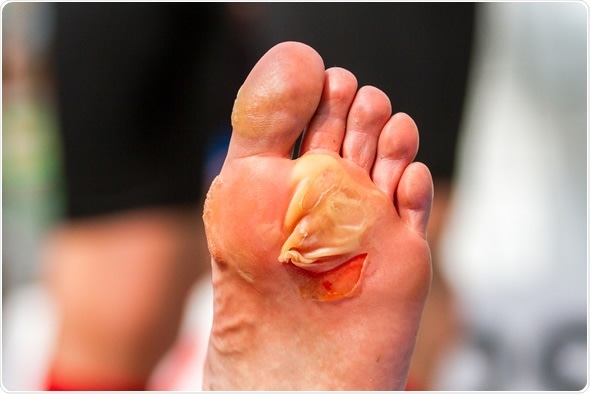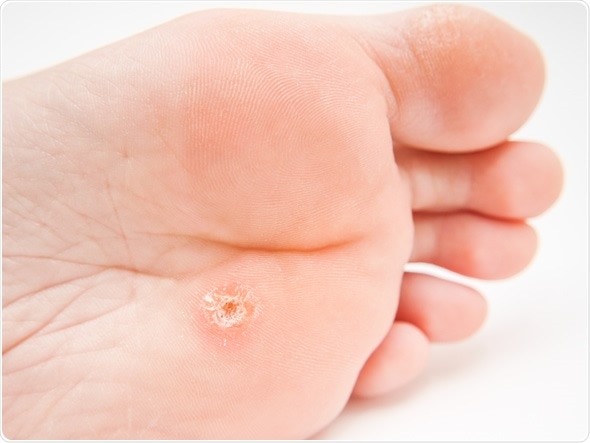Blisters, Corns and Calluses

Blisters, corns and calluses are all fairly common conditions that affect the skin anywhere on the body. Blister and corns develop most commonly over the skin of the hands and feet, while calluses occur mostly on the feet.
Blisters
Blisters form when the epidermis (outermost layer) of the skin becomes damaged and fluid flows in to protect the lower layers of tissue from further damage, creating a raised sac. The fluid in the blister may be clear (serum blisters), bloody (blood blisters) or sometimes infected and purulent. Blisters typically take from three to seven days to heal.

Heat and blisters
Skin blisters may be caused by extreme heat, such as following burns, or exposure to excessive sunlight, as in sunburn.
Friction-related blisters
People also develop foot or hand blisters due to friction. This can happen more easily if the skin is warm and damp, and rubs repeatedly against badly-fitting footwear or against a tool they are using. Serum collects under the surface of the epidermis which separates from the lower layers in such spots, creating a blister. The friction may be chronic, over a long period of time or intense and short-term. In the case of feet, the blister may develop on a bunion or bunionette because it causes the skin to rub against the shoes.
Cold and blisters
Frostbite can result in the formation of blisters on the feet due to tissue damage by the cold, which causes the skin and underlying tissue to freeze. Blood vessels contract under these extreme conditions, forcing blood away to the areas where it is most needed such as key organs. This further aggravates the injury to the skin.
Skin conditions and blisters
Some diseases can also cause blisters such as:
- the itchy skin condition called eczema
- infectious diseases like chickenpox, shingles and cold sores
- certain allergies
Chemicals and blisters
Some chemicals can burn the skin and cause blistering as a result.
Should I burst a blister?
Patients should avoid bursting blisters, to allow the skin to heal properly and avoid the risk of infections. Most of the time, if left alone, the skin over a blister will dry out and eventually peel off. In case the skin over a blister comes off too early, the exposed raw skin should be washed with mild soap and water, and covered lightly to avoid infection.
If the blister is on a surface which faces significant wear and tear, it may be covered with a light sterile dressing. Such dressings should be changed daily after proper hand washing.
Corns
Corns are thickened areas on the body, which form particularly on the feet and hands, and are caused by friction on the skin. They tend to develop in a circle on the bony sides of toes and fingers. When corns occur between the toes, they tend to cause some pain or discomfort when walking.

These hardened areas on the skin can develop under both dry and damp conditions (such as in sweaty areas of the body, like the spaces between the toes), forming hard and soft corns respectively. In addition, deformities of the foot such as bunions may encourage the development of a corn, because they increase friction between adjacent toes.
There are also three other kinds of corn. The seed corn is a type which may develop in little clusters on the skin of the underside of the foot. Vascular corns are supplied with blood vessels in them, and so they bleed if they are cut. Fibrous corns are those which have existed for a long time, and are painful to remove.
Corns are best removed by a medical professional, especially if they occur in diabetic patients. A sharp tool will be used to carefully remove the extra skin.
In many cases, the patient can place a medicated pad or plaster containing salicylic acid over the corn. This chemical will slowly peel off the layers of dead skin that make up the corn.
Calluses
Calluses are areas of thick, hard skin that form around the heel and sole of the foot, and sometimes on the hands as well. Some people have a genetic predisposition to this skin condition on their feet. However, others develop calluses in reaction to the constant friction of ill-fitting footwear, especially if the skin is dry. Older people tend to suffer from calluses more than younger people.

As with corns, calluses are best removed by professionals. However, patients may try out a pumice stone, using gentle friction to wear down the layers of hard skin. Moisturising the skin with an oil-based lotion also helps to prevent or alleviate its dry texture.
References
- NHS Choices on blisters: http://www.nhs.uk/Conditions/Blisters/Pages/Introduction.aspx
- Derm Net on frostbite: http://www.dermnetnz.org/reactions/frostbite.html
- Foot pain explored on blisters: http://www.foot-pain-explored.com/blisters-on-feet.html
Further Reading
- All Foot Content
- Foot Pain Management
- Management of Arch Pain
- Living with Foot Pain
- Flexible vs Rigid Flat Foot
Last Updated: Jun 5, 2019

Written by
Deborah Fields
Deborah holds a B.Sc. degree in Chemistry from the University of Birmingham and a Postgraduate Diploma in Journalism qualification from Cardiff University. She enjoys writing about the latest innovations. Previously she has worked as an editor of scientific patent information, an education journalist and in communications for innovative healthcare, pharmaceutical and technology organisations. She also loves books and has run a book group for several years. Her enjoyment of fiction extends to writing her own stories for pleasure.
Source: Read Full Article